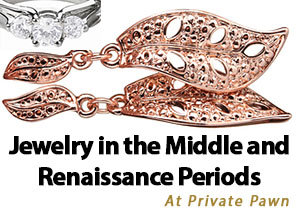Jewelry in the Middle and Renaissance Periods
During the Middle Ages, jewelry was used to display one’s wealth to others. Despite the Sumptuary Laws in place, many middle class citizens wore their jewelry openly as a way to flaunt their wealth and status. Nobility were then inspired to wear even more lavish jewelry to outdo the “commoners.” Individuals living during this time preferred brooches, coronets, necklaces and rings, with the mentality “the more jewelry, the better.” Many pieces of jewelry served a purpose, such as rings worn as a token of betrothal. A good deal of the pieces took their inspiration from classic architectural design, and jewelry became more popular as gemstones were readily available; even clothing became bejeweled during the Renaissance.
By the Renaissance Period in Europe, the use of jewelry to symbolize love and affection was well established. Although gems and precious metals were prized, fake jewelry also became a commodity. Due to their scarcity and exotic origins, pearls were more sought after than even gemstones. Natural white pearls were produced in South India and imported to Europe. Artisans had renewed interest in gem engravings, and created many pieces of jewelry featuring the skill. The evolving artistic styles of the Renaissance began influencing jewelry design, and famous artists even worked with goldsmiths to learn fine detailing and craft. Even hair was adorned with jewels, with women beginning to wear their hair with strands of pearls woven in, as well as delicate ornaments. Queen Elizabeth was fond of this style, as evidenced by paintings dating back to 1575.
Merchants and traders intentionally passed off glass jewelry and fake pearls to the Europeans. Italian craftsman had been making glass gems and pearls for centuries. Their proficiency fooled many experienced gemologists. Special occasions and night events called for more formal jewelry, like diamonds and gems, but for day-wear women would wear false jewelry. The most popular piece of jewelry was the pendant, which would feature designs such as cameos or initials of a loved one. Motifs with mythological animals and imagery from the Bible were often used in these pendants. Pendants were either worn on long chains or attached to a dress bodice. Rings were worn to excess, with some individuals wearing a ring on each finger. Many rings featured intricate carvings, while some were “poison rings” with small chambers to hold locks of hair, substances, and even images. Several ring designs were popular during the time, including fidelity rings and Claddaugh rings from Ireland. Over in Spain, however, men and women had strict conditions under which they were allowed to wear jewelry, thanks to the laws of Phillip II and III.
Other new forms of jewelry became famous in Renaissance Europe, like paste, which was made from lead oxide and potash. Fashion dresses contained gemstones and pearls as opulent ornamentation. Men wore more jewelry and emphasis was put upon having a matching set. No longer was jewelry just a passion for women, but for everyone who could afford it. Jewelry also helped nobility feel secure in their wealth, as it was a valuable commodity that could be sold in case of emergency.
Published By:
Private Pawn Scottsdale – 85257
7841 E. McDowell Rd., Suite 911
Scottsdale AZ 85257
Mesa Locations:
Private Pawn Mesa – 85207
8151 E. Apache Trail, Suite 911
Mesa AZ 85207
Private Pawn Mesa – 85210
1145 S. Mesa Dr., Suite 911
Mesa AZ 85210
Private Pawn Mesa – 85204
361 S. Lindsay Rd., Suite 911
Mesa AZ 85204
Chandler Location:
Private Pawn Chandler – 85225
1731 N. Arizona Ave., Suite 911
Chandler AZ 85225
Phoenix Locations:
Private Pawn Phoenix – 85043
691 W. Baseline Rd., Suite 911
Phoenix AZ 85043
Private Pawn Phoenix – 85022
14601 N Cave Creek Rd., Suite 911
Phoenix AZ 85022
Private Pawn Phoenix – 85019
4135 W. Indian School Rd., Suite 911
Phoenix AZ 85019
Apache Junction Location:
Private Pawn Apache Junction – 85120
900 W. Apache Trail, Suite 911
Apache Junction AZ 85120







